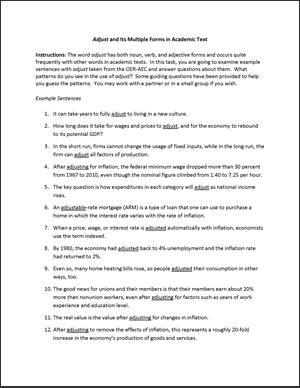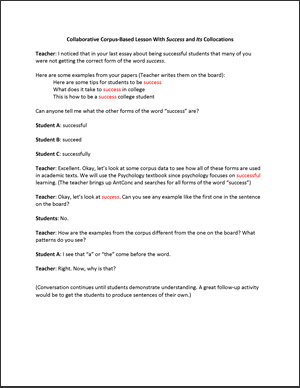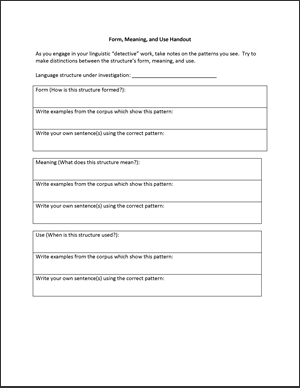Creating ELT Materials Using OER Corpora
by Brent A. Green and Veronica Wright
 Though textbooks provide valuable resources in the second language classroom, they come with a variety of limitations. Some learners complain about the quality of the content or topics. Some teachers feel that there is not enough coverage of particular spoken or written language structures to meet learners’ needs, and the activities or tasks do not provide enough meaningful practice. Because of these limitations, teachers are often required to develop their own materials. Many, however, struggle to find copyright-free source texts which can be used to develop interesting, local, and relevant materials specific to learners’ needs. In addition, teachers and textbook writers regularly rely on their own intuitions to create materials, which often do not accurately reflect actual language use patterns in real world language domains (Biber & Reppen, 2002).
Though textbooks provide valuable resources in the second language classroom, they come with a variety of limitations. Some learners complain about the quality of the content or topics. Some teachers feel that there is not enough coverage of particular spoken or written language structures to meet learners’ needs, and the activities or tasks do not provide enough meaningful practice. Because of these limitations, teachers are often required to develop their own materials. Many, however, struggle to find copyright-free source texts which can be used to develop interesting, local, and relevant materials specific to learners’ needs. In addition, teachers and textbook writers regularly rely on their own intuitions to create materials, which often do not accurately reflect actual language use patterns in real world language domains (Biber & Reppen, 2002).
The Benefits of OER for Creating Materials
Open educational resources (OER) spoken and written materials can be readily accessed using a variety of tools. We have found that these materials, when collected in a corpus, can be used to inform language classrooms and meet a variety of English language teaching (ELT) needs. These resources help teachers make up for some of the aforementioned limitations. The advantages of such corpora are many; they are based on language used in real contexts and they give teachers the rights to
- make, own, and control copies of the content;
- use the content in a wide range of ways;
- adapt, adjust, modify, or alter the content itself;
- combine the original or revised content with other material to create something new; and
- share copies of the original content, revisions, or remixes with others (see OpenContent.org).
We have created a written corpus from OER sources and have used it successfully to develop materials for our English language classes (Green, n.d.). In this article, we demonstrate how you can access and use OER written corpora to create highly effective materials for a variety of classroom teaching purposes in a variety of ESL/EFL contexts.
 Choosing the Right OER
Choosing the Right OER
The first step involves accessing OER materials that match your students’ target language use (TLU) domain, or the area or situations in which the students will use the language in the future (Bachman & Palmer, 1996). For example, at BYU-Hawaii, we work in an academic English program with four levels of instruction. Our TLU domain is introductory level credit-bearing university courses. In preparation for using materials in our context, we searched for OER sources that match our TLU domain. The source we found is OpenStax college textbooks from the OpenStax webpage hosted by Rice University. OpenStax publishes free, openly licensed, peer-reviewed, university-level textbooks. We took the texts from these textbooks, downloaded them, and compiled them into an OER Academic English Corpus (OER-AEC) that is housed at the OER Corpus for EAP website. For those working in K–12 settings, you can most likely find OER materials which meet your specific needs at OER Commons.
Using OER Corpora
Getting Started
In order to use the OER-AEC, we recommend organizing the files and programs by placing them in folders on your desktop for easy access. If you are going to use the corpora in a language lab, you can create the same folders for learner access as well. This will better facilitate teacher-centered, collaborative, and student-centered activities and materials development.
First, create a master folder which names your institution. We named ours BYUH Corpora. Within this folder, create three subfolders and title them as follows:
- Concordancer, where the AntConc program will be located
- Corpora, where the text versions of the OpenStax textbooks will be located
- Other Programs where you will place other Laurence Anthony software and/or OER programs which facilitate creating and using the OER-AEC corpus (i.e., AntFileConverter and AntFileSpliter)
Next, go to the OER Corpus for EAP website and download the files and programs named in the preceding list, saving them in their respective subfolders. The OpenStax textbooks have been converted and are freely available for download at the OER Corpus for EAP website as well. To learn how to begin using AntConc to search for patterns which you will use to create ELT materials, we recommend watching Laurence Anthony’s YouTube channel because there can be a slight learning curve as you begin using corpora searching tools. The videos, especially the first three, are very helpful in explaining the basics and giving you a foundation of knowledge about how these tools work. After gaining a basic overview using the videos, you should be ready to perform the simple searches you need to create materials for your classes.
Creating Materials
Now you are ready to create materials using your OER corpus database. The first thing to do is to identify common errors that your students make. They could be particular grammatical structure(s), single vocabulary, and/or multiword expressions (Hinkel, 2019) that students struggle with and which you want them to learn and practice.
Then, choose the corpus files that match the TLU domain that you want to focus on (i.e., does the target structure occur in a particular subject area of texts, e.g., science or business?). Upload files from the target Corpus subfolder into AntConc and search for the structure of interest.

Create learning opportunities that have students interact with the corpus data that demonstrates the correct pattern of language use. You can do this by identifying example concordance lines from the files that demonstrate the correct pattern of language use. Copy these lines and put them into a worksheet. In the worksheet, provide questions that prompt students to analyze and identify patterns in the concordance lines. You may need to guide students’ discoveries of the patterns at first.
As you create the worksheets and prompts, make sure to have students focus on three areas, as outlined by Larsen-Freeman (2014):
- Form: The rules that dictate the structure of the item
- Meaning: The lexical as well as the grammatical meaning of the structures
- Use: The rules that dictate what contexts are appropriate to use the item in
This approach will help students gain a deeper and more lasting understanding of the items of interest. As students become more familiar with the process, they will begin to become more autonomous and choose their own language structures to research and learn about.
See the Appendix (PDF) for a quick overview, or cheat sheet, of this materials creation process.
Examples
Following are examples of teacher-centered, collaborative, and student-centered materials we developed using our OER corpus, AntConc, and a word processer. Take note that using materials created from corpora involves students playing the role of linguistic detectives, meaning they must infer the patterns from the data presented.
Teacher-Centered
In the following example (Figure 1), the teacher selects the target structure and creates a worksheet for the students. Pairs work together at first and try to inductively come up with the rules. The teacher then explains the rules at the end of the activity.

Figure 1. Teacher-centered worksheet example.
(Click image to enlarge and download PDF)
Collaborative
The following lesson example (Figure 2) is a dialog of a collaborative task which was carried out in one of our classrooms. As you can see, the teacher gives clues and guides the students to their own conclusions.

Figure 2. Collaborative task lesson example.
(Click image to enlarge and download PDF)
Student-Centered
In the following example (Figure 3), students work on the data independently. They demonstrate that they understand the pattern by writing it in their own words, showing examples from the corpus, and finally adding their own sentences using the structure under investigation.

Figure 3. Student-centered worksheet example.
(Click image to enlarge and download PDF)
More examples of materials derived from OER corpus can be found at the OER Corpus for EAP website. Once you feel comfortable using the written corpus, you can expand your repertoire to include OER spoken corpora as well.
Conclusion
We have seen the positive effects of using materials derived from the OER-AEC. They are powerful tools that can help teachers overcome limitations in materials development and help students become autonomous learners equipped with authentic tools and skills that enable them to improve their English long after they have left our classrooms. We hope that the steps and guidelines for using the OER-AEC and the example materials included in this article will open the doors for the use of the OER-AEC in your classrooms.
References
Bachman, L., & Palmer, A. (1996). Language testing in practice. Oxford, England: Oxford University Press.
Biber, D., & Reppen, R. (2002). What does frequency have to do with grammar teaching? Studies in Second Language Acquisition, 24, 199–208.
Green, B. A. (n.d.). OER corpus for EAP. Retrieved from https://sites.google.com/site/oercorpusforeap
Hinkel, E. (2019). Teaching essential units of language: Beyond single-word vocabulary. New York, NY: Routledge, Taylor & Francis.
Larsen-Freeman, D. (2014). Teaching grammar. In M. Celce-Murcia, D. M. Brinton, & M. A. Snow (Eds.), Teaching English as a second or foreign language (4th ed., pp. 256–270). Boston, MA: National Geographic Learning.
Brent A. Green is an associate professor of English language teaching and learning at Brigham Young University–Hawaii. He has a PhD in applied linguistics from UCLA. His interests include language assessment, corpus-driven learning, and ESL/EFL pedagogy. He has taught EFL/ESL, TESOL, developmental education, and linguistics courses in the Marshall Islands, Taiwan, Utah, Tonga, Samoa, California, and Hawaii.
Veronica Wright teaches English as an international language and TESOL courses in the English Language Teaching and Learning Program as an assistant professor at Brigham Young University–Hawaii. Her other interests include vocabulary learning, phrasal vocabulary, the use of conceptual metaphors to understand cultural meaning intertwined with language and the use of metaphors to understand writing structure and organization.